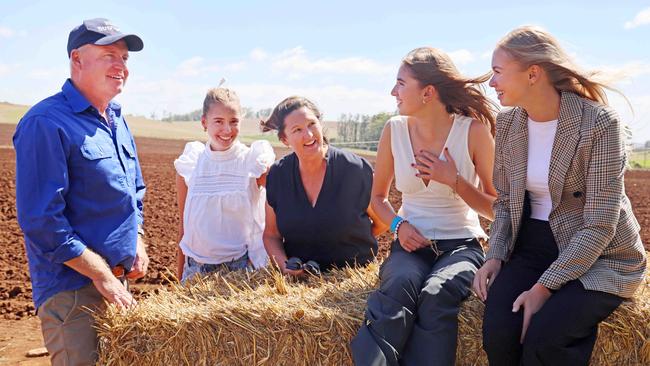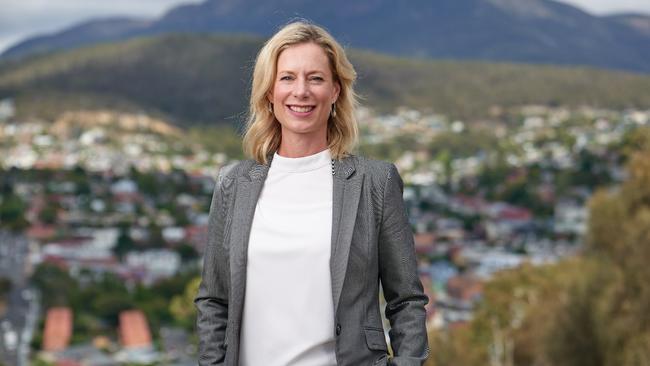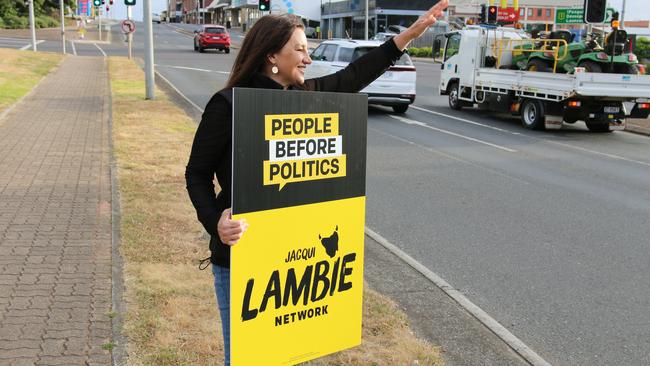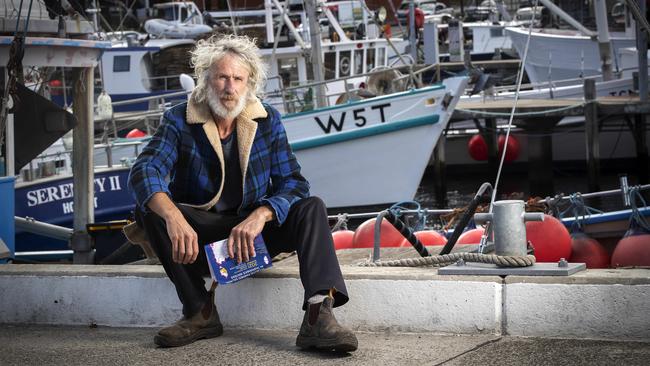Can Australia’s last governing Liberals cling on to power? They’re in for a wild ride
With polls suggesting Tasmania will elect a political potpourri of independents, Lambie-ites and Greens that could make the turmoil of past minority governments look like an accountants’ convention, Jeremy Rockliff is facing the political equivalent of climbing one of the island’s mammoth peaks.

Tasmania appears headed not so much for a hung parliament as one that swings as wildly as a saloon door in a spaghetti western or a 1970s keys-in-the-bowl soiree.
Polls suggest on March 23 the island will elect a political potpourri of independents, Lambie-ites and Greens that could make the turmoil of past minority governments look like an accountants’ convention.
If the last Liberals governing anywhere in the country are to cling to power, it appears they will do so with the help of crossbenchers with vastly different philosophies.
Against a backdrop of failing public services and major party disillusionment, the Rockliff government’s bid to secure a record fourth consecutive majority term is the political equivalent of climbing one of the island’s mammoth peaks.
After 10 years of Liberal government, state hospitals are in crisis, educational attainment is abysmal, public transport is dysfunctional and thousands experience housing stress or homelessness.
Plunged into minority after two of their own defected to the crossbench in May last year, the Liberals are struggling to sound credible in promising “strong, stable, majority government”.
Just to make its electoral mountain even more daunting, the party has – by its own hand – increased the likelihood of a hung parliament by legislating a bigger House of Assembly. Under the state’s unique Hare-Clark system of proportional representation, this lowers the quota for MPs to get elected, opening the door even wider for independents and minor parties.
In polls so far voters are turning to this ideological smorgasbord with gusto, while Labor has flatlined at best despite the fertile electoral ground. It’s a recipe for what Premier Jeremy Rockliff likes to call “a coalition of chaos”, as he tries to talk Tasmanians out of voting for the little guys.
“The only way to deliver the stable, majority government that Tasmania needs … is to vote Liberal,” the Liberal leader tells Inquirer. “A vote for anybody else is a vote for a Labor-led minority government coalition of chaos, which will crash the economy, crash jobs and wreck our health system.”
In the past, such warnings have had potent currency in Tasmania, where alliances – between Labor and the Greens and even Liberals and Greens – have ended in tears and early elections. However, this time it’s a message blunted by voters’ discontent and the Rockliff government’s own instability from defections and scandals.
Labor leader Rebecca White, fighting for her political future after losing two consecutive elections as leader, is relying on an “it’s time” factor. “After 10 years of the Liberals, it’s time for urgent action on the cost of living, health and housing in Tasmania,” White tells Inquirer.
“If the Liberals haven’t fixed these issues after 10 years, they never will – and Tasmanians can’t afford to give them 14.”

Hampering both parties is a rich vein of independents – some party turncoats, some perennial mavericks and others pushed by groups wanting to break the political duopoly. And then there’s an emergent Jacqui Lambie Network.
“Tasmania’s parliament needs new blood – candidates who aren’t backed by unions or big corporate donors, who will vote in the best interests of their community,” Lambie tells Inquirer. “We have a big transparency issue in our parliament and if my candidates are in the balance of power they will hold the major parties to account.”
The campaign, triggered after Rockliff claimed his minority government could no longer work with two ex-Liberal independents, has so far failed to give either major party a clear leg-up. There is a palpable sense that the decade of Liberal ascendancy is over, but what comes next is less certain. Rockliff’s Liberals spent the first half of the campaign seeking to do a Qantas and lose some baggage.

Thus the government’s blank cheque for a new AFL stadium in Hobart was replaced with a cap on taxpayer expenditure of $375m. Rockcliff would have voters believe the expected stadium budget overruns will be covered by as yet unidentified private sector investors.
Similarly, the Liberals sought to assuage unrest at the University of Tasmania’s main campus move (from Sandy Bay to Hobart’s CBD) by announcing parliament would be given the final say. Soaring power prices were met with a Liberal promise of $250 one-off payments to households and a vow to have Hydro Tasmania prioritise Tasmanian’s energy bills over making quick bucks trading on the national energy market.
Rockliff has sought to wedge Labor on forestry, announcing plans that would restart the forest wars by logging 40,000ha of forests protected under the 2012 forests peace deal. And the big achilles heel – health – has been addressed by promising to “effectively ban” ambulance ramping at public hospitals, as well as invest in medico recruitment and hospital rebuilds.
White has stated Labor’s opposition to the stadium but has generally had a less combative and less controversial campaign.
On forestry, Labor has focused on guaranteeing local millers’ access to existing resources rather than logging more native forests.
On power policy, it has – like the Liberals – flagged a Hydro more attuned to local needs than trading on the national electricity market, while also capping power prices and seeking to limit exposure to the Marinus energy project.
White also has unveiled a string of health policies, including more beds and a seed loan for a new Launceston elective surgery centre, as well as paying the HECS debts of 150 medical staff if they work in district hospitals.
Both parties have offered creative policies to boost housing, in particular apartment builds.
Liberal boasts of strong budget management have been undermined by Treasury’s pre-election financial outlook report, revealing deficits as far as the eye can see and net debt soaring from $3.3bn to $6.1bn by 2027. Rockliff has a better story to sell on the economy, which generally has diversified and strengthened since the Liberals came to power in 2014 and bounced back well from the pandemic.
Even so, the cost-of-living crisis means many Tasmanians don’t feel they are better off for it, while Labor can point to rising unemployment, static participation and a worrying 14.7 per cent plunge in businesses’ capital expenditure in the year ending in December.
The Liberals, in particular, have not been afraid to go negative to arrest the electorate’s drift towards mavericks. Liberal adverts feature a traffic light with red, amber and green simultaneously illuminated; an analogy of “the coalition of chaos” should voters fail to back in a blue majority.
Lambie, who polling suggests could have up to four MPs elected on March 23, is unfazed.
“The ‘instability’ line that both major parties push every election is just rubbish,” she says. “The last two Tasmanian Liberal premiers promised they would do a full term, then both of them resigned midterm. This government is stable? Give me a break.
“They’ve been in minority for months because two of their members left the party. Between 2016-17 and 2023-24 … ministerial portfolios were often reorganised every year. Stability my arse.”
Greens leader Rosalie Woodruff is selling the virtues of collaborative government and her party’s track record of providing stability to hung parliaments.
“Liberal and Labor politicians like to run scare campaigns about minority parliaments not providing stability – what they actually want is to be able to make decisions in secret, to push things through parliament without compromise, and to escape accountability,” Woodruff argues.
As to which party they are most likely to support to govern, Lambie says she will leave this to her MPs, based on the final seat count and what appears most workable.
Woodruff is clear in her intention to support Labor, as her party did in 2010-14 and 1989-92, as a means of securing Greens policies.
“The Greens are very clear – we want a new government,” she says. “We’re also clear Labor won’t do enough on these big issues if they’re left to their own devices.
“They have their own corporate donors and special interests in their ear, and can get pulled in the wrong direction … We need the Greens in balance of power to make sure there’s real and lasting change on the big issues facing Tasmania.”
It is a crucial election for the Greens, without key vote-puller and former leader Cassy O’Connor, who quit in July last year to run for Tasmania’s upper house.
The party has broadened its focus to mainstream issues of health, housing and living costs but will benefit from opposition to Rockliff’s native forest logging expansion.
For Lambie, March 23 could be her big moment. A handful of state seats would give her two-woman Senate team a broad new base and announce the JLN as a force to be reckoned with in Hobart as well as Canberra.
Polling so far suggests the Liberals will likely win more seats than Labor, and that whoever forms government will need the support of minor parties and/or independents. Local pollsters EMRS had Liberals on 39 per cent, Labor 26 per cent, independents 14 per cent, Greens 12 per cent, JLN 9 per cent and others 1 per cent. Polling by RedBridge Group has the Liberals on 33 per cent, Labor 29 per cent, Greens 14 per cent, independents 14 per cent and JLN 10 per cent.
It is difficult to extrapolate such polling to Tasmania’s five electorates, which each return seven members under Hare-Clark proportional representation. Tasmania’s system does not allow the ranking of candidates within party tickets or the distribution of how-to-vote cards, while the order of candidates within tickets and groupings is rotated to avoid giving any individual an advantage.
However, Inquirer’s crunching of these numbers suggest the Liberals are on track for 13 to 15 seats in the expanded 35-seat House of Assembly, Labor 10 to 12, Greens two to five, independents four to five and the JLN two to four. A majority is 18 seats.
So while caution is needed, this much is clear: unless the polls are wildly wrong or one of the parties can wrest an advantage in the campaign’s final fortnight, there will be a minority government. And it may need more than one partner.
Labor, as we have seen, will likely have fewer seats than the Liberals but more crossbench goodwill.
Lambie, once a Liberal member, is scathing of Rockliff and his party, which has attacked the JLN relentlessly this campaign. However, she tells Inquirer her MPs could work with either major party.
The independents most likely to succeed are a mixed bag, politically. Some are left leaning, including exiled former Labor leader turned independent David O’Byrne and Kristie Johnston. Several are disaffected ex-Liberal MPs, including Sue Hickey and John Tucker. Others are harder to pin down, such as green-tinged, folksy fisherman Craig Garland.

Both major parties have ruled out a formal power-sharing deal with the Greens while expressing a willingness to govern in minority.
White has ruled out any formal deals, while Rockliff has ruled out trading ministries or policies to win anyone’s support. March 23 will end the campaign but likely mark the beginning of a long limbo period of recounts and horse-trading between the parties and crossbenchers. Failure for White or Rockliff will most likely end their leaderships, if not their careers.
Rockliff has long been rumoured to be hankering for a return to the family farm. Having forced voters to an early election because he could not wrangle two ex-Liberals, he will look foolish if the result is a far more exotic chaos.
It is almost inconceivable that White’s leadership could survive a third election loss, particularly if the party’s primary vote percentage remains stuck in the 20s.
The swings and turns have just begun.








To join the conversation, please log in. Don't have an account? Register
Join the conversation, you are commenting as Logout